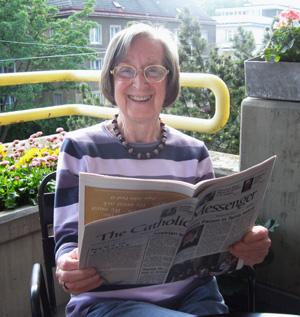
By Barb Arland-Fye
While teaching recently in Europe, Dan Ebener visited Hildegard Goss-Mayr, who will receive the Pacem in Terris Peace and Freedom Award in Davenport Sept. 20. Ebener, an instructor at St. Ambrose University in Davenport and the Davenport Diocese’s stewardship director, first met Goss-Mayr 30 years ago while working for the Fellowship of Reconciliation in New York. She was traveling secretary for the international office of the same organization.
An Austrian, Goss-Mayr’s peace-making efforts of more than 50 years have inspired Nobel Peace Prize winners, bishops and ordinary citizens worldwide. For that reason, Bishop Martin Amos will present the Pacem in Terris award to Goss-Mayr during a 3 p.m. ceremony in Christ the King Chapel on St. Ambrose’s campus on Sept. 20. She is the award’s 39th recipient and is acquainted with a number of past recipients, including Adolfo Perez Esquivel, Dorothy Day, Eileen Egan, James Douglass and Mairead Corrigan Maguire.
Ebener took the opportunity to visit Goss-Mayr at her home in Austria in mid-May, during a weekend break from teaching in Croatia for St. Ambrose. He wanted to get reacquainted, discuss the award ceremony and learn more about her teaching methods in nonviolence.
Upon seeing Goss-Mayr after 30 years, “my first thought was how young she looked for 79, how she gets around so well and how good her English is. Her mind is very sharp,” he said.
“We went for a long walk and talked about Pacem in Terris and how you teach nonviolence. She talked about the list of previous (Pacem in Terris) recipients and the fact that many of them had been her friends and colleagues.”
Goss-Mayr and her husband Jean, who died in 1991, worked as a team in peace-keeping efforts around the world: Europe, Latin America, South America,; Spain, the Philippines and Africa among other places.
“She grew up in a family where her parents were active in the Catholic peace movement and International Fellowship of Reconciliation, and in those relationships she knew many clergy (mainly Catholic, but also Protestants and Orthodox),” said Richard Deats, who wrote “Marked for Life,” a new biography about Goss-Mayr.
“She developed boldness in speaking with the power of the Gospel and felt right at home in requesting, and receiving, interviews, discussions with leading clergy. Jean was like her in boldness,” observed Deats, who will accompany Goss-Mayr to Davenport for the award presentation.
In her conversations with Ebener, Hildegard said she saw her work as that of a “midwife,” or “birth helper” for the development of nonviolence in the Catholic tradition. Using examples of Vatican II and the Latin American Catholic bishops’ conferences at Medellin and Puebla, where the Mayrs worked in the background, she said the bishops just needed a circle of support for the idea of nonviolence. Even those who were committed to the poor were not necessarily committed to nonviolence.
When asked to identify her most important achievement, she pointed to “many committed bishops” who began to recognize nonviolence as “a liberating power.”
Early in their work, uniting justice with nonviolence was “a revolutionary concept” for many people, she said. Jean insisted that nonviolent action needed to be “more than a Band-Aid.” She said the people who began to articulate this most effectively were Archbishop Dom Helder Camara of Brazil, Archbishop Oscar Romero of El Salvador, Bishop Desmond Tutu of South Africa and Martin Luther King Jr.
Hildegard told the story of Dom Helder struggling initially with this concept. After attending one of the Mayrs’ seminars, Dom Helder, who had been involved in building houses for the poor, came out with his hands up, boldly proclaiming, “I am a nonviolent bishop.” Jean replied, “Not until you do something.” (Hildegard laughed at this memory). Jean told Dom Helder that he could build houses for a century, but it wasn’t going to change anything until he also changed the social structures.








